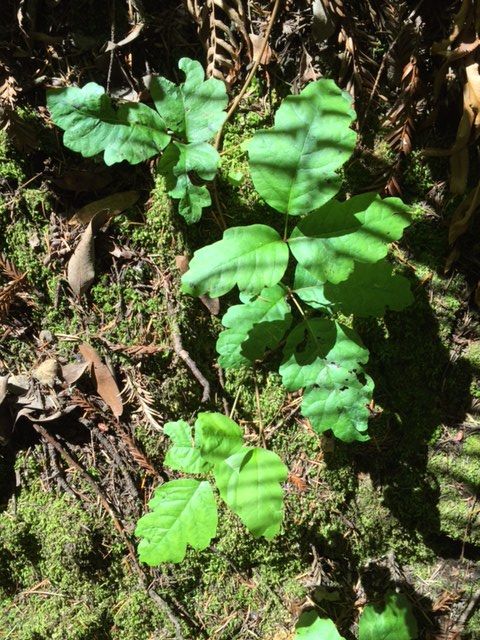I’ve received several emails lately, requesting more information about something mentioned in a recent column. Also, I received a phone call from a reader describing a bad encounter with a certain common plant — poison oak.
She wanted to share her experience so it wouldn’t happen to anybody else, and a conversation about how bad the poison oak is this year, triggered a discussion about how to dispose of the stuff. So here goes. All the news that’s fit to print.
Whether it was Joe Friday who said it, or Dan Akroyd in the Dragnet parody, we all want: “Just the facts, ma’am.”
In my column a couple weeks ago about garden planning for the drought, it was the last line “And don’t forget the… mulch (no shredded bark, please)” that caused a bit of confusion. It’s great that everyone has accepted the value of covering the soil with organic mulch.
Organic mulches — such as bark chips, treated sawdust, straw, or even grass clippings, keep plant roots cool, encourage earthworms and other beneficial organisms, conserve soil moisture, combat weed growth, and protect the soil from erosion.
But is one organic mulch better than another?
There are many types of mulch available. Nurseries sell different kinds of mulch in bags, and building supply yards carry everything from bark nuggets in different sizes, to treated sawdust, to chipped bark, and even shredded redwood bark.
Shredded redwood bark, also called gorilla hair, does nothing for the health of your soil. If you have a very steep slope you may have to go with this type of mulch, but that’s the only time I can recommend it. It will cling to a hillside without washing down in winter rains — treated sawdust would also work for this type of terrain, and is much better for soil health.
Of all the types of organic mulches out there, recent studies have shown that ramial bark chips are one of the best mulches to improve soil health.
Ramial chips come from trees and brush with branches up to about 3-inches in diameter, with or without leaves. These chips contain a high percentage of thin young bark and young wood, which makes them incredibly valuable to the garden.
Young wood is a tree’s factory for producing protein, glucose, fructose, lignin, and polysaccharides. It is an important source of nutrients for living things — at all levels —according to a study by soil scientists, G. Lemieux and R.A. Lapointe.
You can obtain these kinds of chips free from tree trimming companies, who are probably working nearby chipping roadside brush for PG&E.
About that call from a reader who had a terrible experience after pulling some plants in her yard that had gotten a little out of hand. The reader said that she and her husband ended up with severe eye burn after getting some toxic sap from euphorbia in them. She said they weren’t sure if some of sap became airborne while they were pulling stems, or if they accidentally rubbed some near their eyes at some point in the day.
They went to Urgent Care right away for treatment, but the pain lasted for days, she described it as one of the most painful experiences she has ever had.
Euphorbias are very deer resistant and drought tolerant, and are being used more and more in gardens.
Many of us, me included, grow tropical milkweed or Asclepias curassavica, to attract monarch butterflies. The milky sap from this plant protects the monarch from being eaten and can cause the same painful burning of the eye.
I read of a case where a gardener’s clothes brushed some stems while she was tending the garden, later she wiped the sweat out of her eyes and didn’t realize she had also touched her pants. She ended up with cornea burn, causing temporary blindness, and had to take strong pain relievers and steroids to elevate the pain.
Lastly, a fine crop of poison oak is growing this year, so thick in places that you can barely avoid it. The new foliage literally glistens with toxic oils.
Many birds relish the white berries that form later in the season, but nine out of 10 people will get a rash if even one drop of urushiol oil touches their skin — and this oil has lasting power. It can stay active on any surface, including dead plants, for up to five years.
Burning dead or dormant poison oak branches is especially dangerous, as urushiol oils released in smoke can produce disastrous results if inhaled.
So what to do with the stuff if you pull it out?
Do not put it in your green waste can — it could end up being ground into mulch along with other green waste — instead put it in your gray garbage can. Other plant matter that needs to be put in the gray garbage can is pampas grass and bamboo.
So that’s the skinny on shredded redwood or gorilla hair, common plants with toxic sap, and poison oak disposal.
Be careful out there.
– Jan Nelson, a landscape designer and California certified nursery professional, will answer questions about gardening in the Santa Cruz Mountains. E-mail her at ja******@*ol.com, or visit www.jannelsonlandscapedesign.com to view past columns and pictures.













